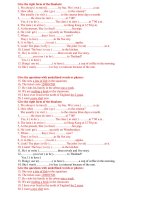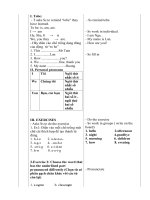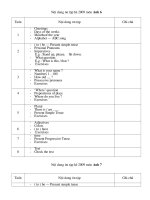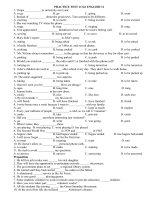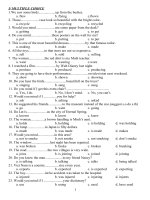Bài tập ôn tập ANh 7
Bạn đang xem bản rút gọn của tài liệu. Xem và tải ngay bản đầy đủ của tài liệu tại đây (1.24 MB, 16 trang )
<span class='text_page_counter'>(1)</span><div class='page_container' data-page=1>
Unit 7: TRAFFIC
<b>TEST 1 - A. LANGUAGE</b>
<b>A. PHONETICS</b>
<b>I. Find the word which has a different sound in the part underlined.</b>
<b>1. A. head</b> <b>B. break</b> <b>C. bread</b> <b>D. heavy</b>
<b>2. A. said</b> <b>B. wait</b> <b>C. maid</b> <b>D. sail</b>
<b>3. A. start</b> <b>B. lake</b> <b>C. station</b> <b>D. came</b>
<b>4. A. ancient</b> <b>B. radio</b> <b>C. nature</b> <b>D. village</b>
<b>5. A. indicate</b> <b>B. mistake</b> <b>C. take</b> <b>D. says</b>
<b>II. Underline the letters with sound /e/, and circle the letters with sound /ei/.</b>
1. There used to be many traffic accidents in this street.
2. Mr. Lake takes the train to work every day.
3. Betty is walking on the pavement and waving to her friend.
4. They came to Spain to visit many stadiums and went around by tram.
3. They were waiting at the railway station to meet their friends from Spain.
<b>B. VOCABULARY & GRAMMAR</b>
<b>I. Put the means of transport into the correct groups.</b>
<b>II. Put the types of transport into the correct group of the verb. Some types of transport can be used</b>
<i><b>more than once, and used with the article “a” or “the”.</b></i>
<b>1. take: ___________________________________________________________________________________</b>
<b>2. get on: _________________________________________________________________________________</b>
<b>3. get off: _________________________________________________________________________________</b>
<b>4. go by: __________________________________________________________________________________</b>
<b>5. ride: ___________________________________________________________________________________</b>
<b>III.Match the road signs with their meanings, and then write the correct answers ill blanks.</b>
1. Go ahead only _____________
2. Go left only _____________
3. Go right only _____________
4. No Parking _____________
5. Cars prohibited _____________
6. Stop _____________
7. No Stopping & No Parking __________
8. Overtaking prohibited __________
9. Trucks prohibited __________
10. All motor vehicles prohibited __________
11. No U-tums __________
12. Overtaking prohibited for trucks __________
<i>bicycle (bike)</i> <i>boat</i> <i>bus</i> <i>car</i> <i>coach</i> <i>helicopter</i>
<i>lorry</i> <i>motorbike</i> <i>plane</i> <i>moped</i> <i>ship</i> <i>taxi</i>
<i>train</i> <i>tram (streetcar)</i> <i>underground</i> <i>van</i> <i>caravan</i> <i>kayak</i>
<b>Land</b> <b>Air</b> <b>Sea</b>
………
…
………
…
………
…
………
…
………
…
………
…
………
…
………
…
………
…
<i>bus</i> <i>plane</i> <i>train</i> <i>taxi</i> <i>car</i>
</div>
<span class='text_page_counter'>(2)</span><div class='page_container' data-page=2>
<b>A</b> <b>B</b> <b>D</b> <b>E</b>
<b>F</b> <b>G</b> <b>H</b> <b>I</b>
<b>J</b> <b>K</b> <b>L</b> <b>M</b>
<b>IV. Look at signs A-F. What do they mean? Underline the correct option.</b>
<i><b>A. Motorbikes don’t have to/ can’t go here. They have to/ don't have to go on another road.</b></i>
<i><b>B. You can/ have to park here for free. You can’t/ don’t have to pay for fifteen minutes parking.</b></i>
<i><b>C. Bikes have to/ can keep left. People on foot don’t have to/ can’t walk on the left</b></i>
<i><b>D. You can/ can't catch the bus here. You have to/ don't have to wait more than ten minutes.</b></i>
<i><b>E. You can’t/ don’t have to ride your bike. You can/ have to get off and walk.</b></i>
<i><b>F. You can/ can't take a taxi here. You can/ can't park here.</b></i>
<b>V. Look at the signs, and then do the tasks that follow.</b>
FREE
EVERY
</div>
<span class='text_page_counter'>(3)</span><div class='page_container' data-page=3>
<i><b>a</b></i>
<i><b>b </b></i>
<i><b>c </b></i>
<i><b>d </b></i>
<i><b>e</b></i>
<i><b>f </b></i>
<i><b>g</b></i>
<i><b>h</b></i>
<i><b>i</b></i>
<i><b>j </b></i>
<i><b>k </b></i>
<i><b>l</b></i>
<i><b> </b></i><i><b>m</b></i>
<i><b>A. Which signs might you see:</b></i>
in the street?____________________
in a hospital?____________________
in a park?_______________________
in a museum? ___________________
at an airport?____________________
<i><b>B. Complete the sentences with have to, don’t have to, can or can’t, and then match signs a-m to the</b></i>
<i><b>sentences below. Sign c has been done for you as an example.</b></i>
<i><b>Example: -c- You have to stop.</b></i>
_______ 1. Dogs go here.
_______ 2. You ride a bicycle here, but you drive your car.
Mon-Fri, 8.30am-6.30pm
£1.50 for 2 hours
Mon-Fri, 6.30pm-8.30am
Sunday, all day
FREE
ENTRY FEES
ADULTS: €10
CHILDREN OVER 5: €4
CHILDREN UNDER 5: FREE
</div>
<span class='text_page_counter'>(4)</span><div class='page_container' data-page=4>
_______ 3. You pay in the evening or on Sundays.
_______ 4. You play football here.
_______ 5. You take photos.
_______ 6. Adults and children over five pay, but children under five pay.
<b>_______ 7. You </b> use this toilet.
_______ 8. You use Visa or MasterCard but you use American Express.
_______ 9. You show your passport.
_______ 10. You use a mobile in here.
_______ 11. You walk on the paths, not the grass.
_______ 12. You smoke in this area.
<b>VI. Complete the following sentences using a different verb or expression. Don’t change the meaning.</b>
<b>Number 0 has been done for you as an example.</b>
0. She never drives to the shops.
<i><b>She never goes to the shops by car.</b></i>
1. In bad weather, I take the bus to school.
In bad weather, I to school .
2. I always walk to my grandparents’ house.
I always to my grandparents’ house .
3. I usually go to school by bike.
I usually to school.
4. Do you go to school on foot?
Do you to school?
5. My father usually goes to work by car.
My father usually to work.
6. My mother drives me to the bus station.
My mother me to the bus station by .
<i><b>VII. Complete the sentences with “used to” or “didn’t use to”.</b></i>
1. I like sports, but now I do a lot of different sports.
2. I be afraid of heights, but then I started climbing hills.
3. I like putting my head in the water because I couldn’t swim.
4. I go skating until I met Anna in Switzerland, and then we have practised a lot so
far.
</div>
<span class='text_page_counter'>(5)</span><div class='page_container' data-page=5></div>
<span class='text_page_counter'>(6)</span><div class='page_container' data-page=6></div>
<span class='text_page_counter'>(7)</span><div class='page_container' data-page=7>
Unit 7: TRAFFIC
<b>TEST 2 - B. SKILLS</b>
<b>C. SPEAKING</b>
<b>I. Read the following conversations: five teenagers are talking about their journeys to school. Complete</b>
<b>the table, and then practise asking and answering the three questions about the teenagers.</b>
1. How far is it from his/ her house to the school?
2. How does he/ she go to school?
3. How long does it take him/ her to go to school?
<b>Distance</b> <b>Time</b>
<b>1. David</b> kilometers minutes
<b>2. Susan</b> kilometers minutes
<b>3. Paul</b> kilometers minutes
<b>4. Ann</b> kilometers minutes
<b>5. Joe</b> kilometers minutes
<b>1. David</b>
<b>Interviewer: How far do you live from the school?</b>
<b>David:</b> About one kilometer.
<b>Interviewer: And how do you get to school?</b>
<b>David:</b> I usually walk to school.
<b>Interviewer: How long does it take?</b>
<b>David:</b> About 15 minutes.
<b>2. Susan</b>
<b>Interviewer: How far do you live from the school?</b>
<b>Susan:</b> I live in a village, about six kilometres away.
<b>Interviewer: How do you get to school?</b>
<b>Susan:</b> My dad drives me to school in the morning. He works near the school. But he finishes work
late so I go home by bus.
<b>Interviewer: And how long does it take?</b>
<b>Susan:</b> About 20 or 25 minutes
<b>3. Paul</b>
<b>Interviewer: How far is it from your house to your school?</b>
<b>Paul:</b> I live just round the comer - about 200 metres.
<b>Interviewer: So do you go to school on foot?</b>
<b>Paul:</b> Yes, usually. Or sometimes I go by bike.
<b>Interviewer: How long does it take you to go to school by bike?</b>
<b>Paul:</b> Just two or three minutes.
<b>4. Ann</b>
<b>Interviewer: How far do you live from the school?</b>
<b>Ann:</b> I’m not sure - about two or three kilometres, I think.
<b>Interviewer: And how do you get to school?</b>
</div>
<span class='text_page_counter'>(8)</span><div class='page_container' data-page=8>
<b>Interviewer: How long does it take?</b>
<b>Ann:</b> About twenty minutes.
<b>5. Joe</b>
<b>Interviewer: How far do you live from the school?</b>
<b>Joe:</b> About four kilomefres.
<b>Interviewer: How do you come to school?</b>
<b>Joe:</b> I go by underground.
<b>Interviewer: How long does it take?</b>
<b>Joe:</b> It takes five minutes to walk to the station, ten minutes on the train, and another five minutes
from the station to the school.
<b>II. Work in pairs. Ask and answer the questions.</b>
1. How far is it from your house to the school? - About
.
2. How do you come/ get/ go to school? – I
.
3. How long does it take? – It
.
<b>D. READING</b>
<b>I. Read the following passage about driving laws around the world, and then tick the correct answers:</b>
<i><b>true (T), or false (F).</b></i>
In Sweden, it is necessary to keep your headlights on 24 hours a day. We understand that it is required for
places as cold as Sweden during winter, but you cannot turn off your car’s lights even if it is June and the
weather looks just fine.
If you are driving in Beijing and you come across a zebra crossing, don’t stop or even try to slow down
because this will get you in trouble with the law.
In Thailand, it is compulsory to wear a shirt while driving. Women who go topless while driving can be
fined equal to a few hundred baht.
In Cyprus, you should keep both hands on the wheel. Drivers who unnecessarily raise a hand from the
steering wheel can get fines, although we think that making some gestures at bad drivers is sometimes good.
Don’t yell or curse while you are driving in Rockville, Maryland, USA although you are right. It is illegal to
curse in public. You have to pay a fine up to $100 or go to prison up to 10 days.
Before you drive off with a car in Denmark, you must check that the children in your car have the best
places. Maybe the reason is that they can read books by Hans Anderson.
Drinking and driving is illegal in Spain, but in Macedonia, if you are drunk, you cannot sit in the front seats.
<b>True</b> <b>False</b>
1. Use your car’s headlights 24 hours a day in Sweden.
2. In Sweden, you have to turn on your car’s lights in June when the weather is bad.
3. In Beijing, it is against the law to stop at a zebra crossing.
4. In Thailand, you have to wear a shirt while driving.
5. There are no rules about what women have to wear while they are driving in Thailand.
6. In Cyprus, you cannot shake your fist (a hand with the fingers and thumb held tightly in)
at other drivers.
</div>
<span class='text_page_counter'>(9)</span><div class='page_container' data-page=9>
8. If you yell or curse while you are driving in Rockville, Maryland, USA and don't pay
the fine, you may be put in prison up to 90 days.
9. Children can have best places while they are riding in a car in Denmark.
10. Don’t sit in the front seats if you are drunk in Macedonia, Spain.
<b>II. Read the following text, and then answer the questions.</b>
<i><b>Bike safety</b></i>
Children under 10 should always ride with an adult.
You must wear an approved cycle helmet correctly.
Make sure bikes have working brakes.
Wearing a high visibility vest or jacket, especially at night, is a good idea.
You should copy the way you see your parents riding their bikes.
1. At which age can children ride their bikes alone?
________________________________________________________________________________________
2. What must you wear while riding?
________________________________________________________________________________________
3. What should your bike have?
________________________________________________________________________________________
4. What should you wear when you ride at night?
________________________________________________________________________________________
5. Is the way your parents ride their bikes a good example for you to follow?
________________________________________________________________________________________
<b>III.Read the texts about model good road safety behavior at all times for parents, and then answer the</b>
<b>questions.</b>
<b>Top tips for pedestrian safety</b>
Teach your children to hold hands with an adult whenever they go out.
Always use a zebra crossing when one is available and teach children that these are the safest
places to cross.
Teach children that it’s still important to stop, look and listen at a zebra crossing.
Teach children always to stop at the kerb and look and listen for traffic (a third of children
injured on roads said that they didn’t stop before stepping off the kerb and many said they didn’t
look).
Never use your mobile phone while crossing roads.
Children learn to make decisions about crossing the road and parents gradually let them take a
lead when you are crossing together.
As children get older, practise routes with them before they walk alone.
<b>Top tips for cycling</b>
Always encourage children to wear a cycle helmet when they are on their bikes, and set a good
example by wearing one yourself.
Children need to be able to judge speed and distance accurately before they cycle on public
roads. They need to take lessons on cycling in order to travel more widely on their bikes.
</div>
<span class='text_page_counter'>(10)</span><div class='page_container' data-page=10>
________________________________________________________________________________________
2. Where should children cross the street?
________________________________________________________________________________________
3. What should children do to cross the street?
________________________________________________________________________________________
4. Where should children stop to look and listen for the traffic?
________________________________________________________________________________________
5. Can they use their mobile phones while crossing roads?
________________________________________________________________________________________
6. What should parents do to help older children before they walk alone?
________________________________________________________________________________________
7. What should children wear when they are on the bikes?
________________________________________________________________________________________
8. What should children do before they cycle on public roads?
________________________________________________________________________________________
9. Which clothes should children wear whenever they are cycling on the road?
________________________________________________________________________________________
10. What should they do when they cycle in the dark?
________________________________________________________________________________________
<b>E. WRITING</b>
<b>Make sentences using the words and phrases given.</b>
1. The traffic/ a nightmare/ visitors/ Viet Nam/ the first time.
________________________________________________________________________________________
2. There/ transport rules/ but/ many people/ not seem/ really interested/ follow/ them.
________________________________________________________________________________________
3. Three or four people/ one motorbike/ a common sight/ particularly/ young people.
________________________________________________________________________________________
4. The traffic/ worst/ rush hours/ when/ everyone/ try/ get to work/ get home quickly.
________________________________________________________________________________________
5. Some people/ ride/ motorbikes/ the pavements/ rather than/ waiting/ a traffic jam.
________________________________________________________________________________________
6. Pedestrians/ get injured/ hit easily/ when/ they/ walk/ the pavements/ cross the roads/ such times.
________________________________________________________________________________________
7. Road users/ very impatient/ quite aggressive/ constantly using their horns/ even shouting/ others.
________________________________________________________________________________________
8. Some people/ install/ air horn/ their motorbikes/ this/ really annoying/ other people/ sometimes/ it/ cause/
accidents.
________________________________________________________________________________________
9. Another problem/ the increase/ the number/ cars/ the road.
________________________________________________________________________________________
10. More people/ own/ private cars/ it/ make/ the problem/ the traffic jams/ worse.
</div>
<span class='text_page_counter'>(11)</span><div class='page_container' data-page=11></div>
<span class='text_page_counter'>(12)</span><div class='page_container' data-page=12>
<b>TEST 3 (UNIT 7)</b>
<i><b>I. Look at the road signs. Write the rules beginning with “You can/ can’t” or “You have to”, using the</b></i>
<b>cues in the box.</b>
1. ________________________________________________________________________________________
2. ________________________________________________________________________________________
3. ________________________________________________________________________________________
4. ________________________________________________________________________________________
5. ________________________________________________________________________________________
6. ________________________________________________________________________________________
7. ________________________________________________________________________________________
8. ________________________________________________________________________________________
9. ________________________________________________________________________________________
10. ________________________________________________________________________________________
<b>II. Find the word which has a different sound in the part underlined.</b>
<b>11. A. lazy</b> <b>B. date</b> <b>C. hate</b> <b>D. car</b>
<b>12. A. said</b> <b>B. wait</b> <b>C. train</b> <b>D. paid</b>
<b>13. A. safety</b> <b>B. waste</b> <b>C. taste</b> <b>D. chat</b>
<b>14. A. security</b> <b>B. belt</b> <b>C. let</b> <b>D. centre</b>
<b>15. A. head</b> <b>B. seat</b> <b>C. heavy</b> <b>D. weather</b>
<b>III.Choose the correct answer.</b>
16. does it take to go from Ha Noi to Ho Chi Minh City by plane?
<b>A. How far</b> <b>B. How much</b> <b>C. How long</b> <b>D. How many</b>
17. There a bus station in the city centre, but it has been moved to the suburbs.
<b>A. used to be</b> <b>B. used to have</b> <b>C. use to have</b> <b>D. were</b>
18. I marbles when I was young, but now I didn’t.
<b>A. play</b> <b>B. used to play</b> <b>C. have played</b> <b>D. didn’t use to play</b>
<i>buy petrol</i> <i>enter</i> <i>give way</i> <i>go</i> <i>go faster than</i>
</div>
<span class='text_page_counter'>(13)</span><div class='page_container' data-page=13>
19. “ is it from your house to the nearest bus stop?” - “About 50 metres.”
<b>A. How far</b> <b>B. How long</b> <b>C. How often</b> <b>D. How much</b>
20. We should the sheet at the zebra crossing.
<b>A. walk</b> <b>B. walk on</b> <b>C. walk through</b> <b>D. walk across</b>
21. Drivers have to your seatbelt whenever they drive.
<b>A. put</b> <b>B. tie</b> <b>C. fasten</b> <b>D. put on</b>
22. We should wait for the traffic lights before we cross the street.
<b>A. turn green</b> <b>B. to turn green</b> <b>C. turn yellow</b> <b>D. to turn yellow</b>
23. All of us have to obey strictly.
<b>A. traffic rules</b> <b>B. traffic</b> <b>C. traffic jam</b> <b>D. regular</b>
24. Cyclists and motorists have to wear a when they ride a motorbike.
<b>A. hard hat</b> <b>B. cap</b> <b>C. mask</b> <b>D. helmet</b>
25. He forgot to give a before he turned left and got a ticket.
<b>A. signal</b> <b>B. sign</b> <b>C. light</b> <b>D. hand</b>
<b>IV. Complete the sentences with the phrases in the box.</b>
26. Roadworks have caused throughout the city centre.
27. Slow down because you’re breaking the .
28. A is a place on a road at which vehicles must stop to allow people to walk across
the road.
29. A is an official document that shows you are able to drive.
30. We needed to get to Ha Noi, but we had no .
31. I have two available to go to Lao Cai. Would you like to go with me to Sa Pa?
32. The government has introduced a new campaign in an attempt to reduce the number of road accidents.
33. We looked on our map to find the way to the .
34. You should know the regulations in order to become a good .
35. A is a hard hat which covers and protects the whole head, worn especially by
motorcyclists.
<b>V. Read the following passage about driving laws around the world, and then tick the correct answers:</b>
<i><b>true (T), or false (F).</b></i>
<i><b>Car safety for children</b></i>
<b>Make sure:</b>
children sit in the back seat
small children use a child restraint or booster seat that fits them
everyone is wearing their safety belts and they are fitted correctly
children get in and out on the footpath side of the car
children walk with their parents to the school gate in the mornings, and after school children
walk with their parents to the car
take extra care on wet days
children should only play outdoors in areas protected well from traffic, including driveways
children need to ask an adult to get the ball that goes onto the road while they are playing
<i>train tickets</i> <i>railway station</i> <i>means of transport</i> <i>traffic jams</i> <i>road safety</i>
</div>
<span class='text_page_counter'>(14)</span><div class='page_container' data-page=14>
<b>True False</b>
36. Children should sit in the front seat.
37. Small children should have special seats for their own security while riding in a car.
38. Only children should wear seatbelts when they are on a car.
39. Make sure that the seatbelts are fitted correctly.
40. Children can get in and out from both sides of the car.
41. It is for the safety of children that they have to get in and out on the footpath
side of the car.
42. Parents should walk to the school gate with their children in the mornings.
43. After school, parents should walk to the school gate to meet your children and walk
them to the car.
44. Children should be more careful when it is a rainy day.
45. Children can walk across the street to pick up the ball without help from an adult.
<b>VI. Read the following passage about driving laws around the world, and then tick the correct answers:</b>
<i><b>true (T), or false (F).</b></i>
Keep your car clean and shiny if you are in Russia, because driving a dirty car can get you fined
up to 2,000 rubles (about $57).
In Costa Rica, you can drink beer while driving if you don’t get drunk. You can drink beer with
one hand and drive your car through the winding roads of Costa Rica.
Make sure that you have enough fuel in your car tank when you drive in the famous high street
in Germany - Autobahn. If you run out of gas, you will break the law.
Drivers in France are required to carry a breathalyzer kit in their cars. Originally, drivers who
didn’t have one were required to pay a fine of €11, but this has been delayed.
If you are not drunk, don’t get in a car with a drunk driver. In Japan, sober passengers with a
drunk driver can be punished under the law.
In Cyprus, eating or drinking (even water) while driving is illegal. Eating a quick snack or taking
a sip of soda will make you pay an €85 fine.
Luxembourg is serious about security, and cars are not allowed to drive if they are not equipped
with working windshield wipers.
In Manila, the Philippines, you cannot drive your car on Monday if the number plate ends with 1
or 2.
<b>True False</b>
46. You are fined when you drive a dirty car in Russia.
47. In Costa Rica, you can drink beer while you are driving.
48. In Costa Rica, you can drive your car with one hand.
49. Don’t run out of gas on Germany’s Autobahn.
50. Bring your own breathalyzer while you are driving in France.
51. In France, you will get a fine if you don’t bring your own breathalyzer while
driving nowadays.
52. In Japan, make sure that your driver isn’t drunk too.
53. In Cyprus, drinking but not eating is allowed while you are driving.
54. Make sure that the windshield wipers of your car work well while driving in
Luxembourg.
</div>
<span class='text_page_counter'>(15)</span><div class='page_container' data-page=15>
<b>VII. Read the text and answer the following questions.</b>
The streets are crowded with traffic. Taxis are bringing tired people from the airport and the train stations to
the hotels. They hope to sleep a few hours before their busy day in the big city. Trucks are bringing fresh fruits
and vegetables into the city. Ships are bringing food and fuel to the harbour.
By seven o’clock in the morning, the streets are filled again with people. Millions of people live in the big
city, and millions of people who work in the big city live in the suburbs, the commuters, are hurrying to get to
their offices. Everyone is in a hurry. Some stop only to drink a cup of coffee. Others stop to buy the morning
paper or to have breakfast.
The noise of traffic gets louder. The policemen blow their whistles to stop the traffic or to hurry it along.
56. Where do taxis often take people from?
________________________________________________________________________________________
57. What are trucks bringing? And what about ships?
________________________________________________________________________________________
58. Who are commuters?
________________________________________________________________________________________
59. What do people often do when they are in a hurry in the early morning?
________________________________________________________________________________________
60. What do the policemen do to control the traffic?
________________________________________________________________________________________
<b>VIII. Complete the second sentence so that it has a similar meaning to the first.</b>
61. I usually stayed up late to watch football matches last year, but now I don’t.
I used
.
62. There were some frees in the field, but now there aren’t any.
There used
.
63. Linda doesn’t live with her parents any more.
Linda used
.
64. He is not a poor man any more, but he becomes a rich businessman.
He used
.
65. They didn’t often go to the cinema every Sunday last year.
They didn’t use
.
66. My hair now is much longer than that in the past.
In the past my hair used
.
67. I don’t have time to collect stamps as when I was in primary school.
I used
.
68. Did you often go to the beach when you lived in Nha Trang?
Did you use
.
</div>
<span class='text_page_counter'>(16)</span><div class='page_container' data-page=16>
Mr. Nam
.
70. There were traffic jams in this street during rush hours, but now the street becomes wider.
There
.
<b>IX. Write a paragraph about traffic problems and the solutions, using the cues given and the words to</b>
<i><b>show sequence like: first, second, moreover, in addition,..., at last.</b></i>
71. Most streets/ roads/ our city/ narrow/ in bad conditions.
________________________________________________________________________________________
72. Many people/ not strictly follow/ traffic laws/ when using the roads.
________________________________________________________________________________________
73. For example/ they/ cross/ sheet/ wrong places/ ride/ motorbikes/ wrong direction.
________________________________________________________________________________________
74. Many street vendors/ occupy/ pavement/ display/ goods/ sale/ pedestrians/ walk/ in the road.
________________________________________________________________________________________
75. The number of trucks/ our city/ very big/ so/ they/ interfere/ traffic flow.
________________________________________________________________________________________
76. Construction/ houses and buildings/ not carefully planned/ so/ they/ occupy/ surface of the roads.
<i>________________________________________________________________________________________</i>
<i>To solve the traffic problems in our city, we should do many things.</i>
77. All streets/ be widened/ and traffic lines/ more logical.
________________________________________________________________________________________
78. We/ encourage/ people/ use public transport/ theft personal vehicles.
________________________________________________________________________________________
79. Heavy penalties/ use/ for/ careless/ dangerous drivers. People/ be educated/ traffic regulations/ at the same
time.
________________________________________________________________________________________
80. In short/1 hope/ traffic problems/ our city/ be solved/ so that/ we/ feel/ comfortable/ when/ use the road.
</div>
<span class='text_page_counter'>(17)</span><div class='page_container' data-page=17></div>
<span class='text_page_counter'>(18)</span><div class='page_container' data-page=18></div>
<!--links-->
